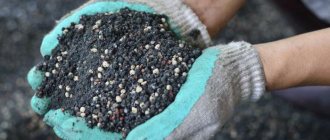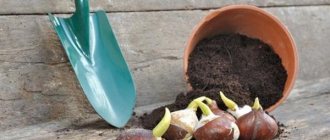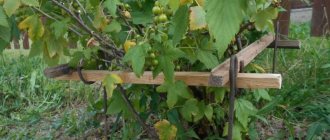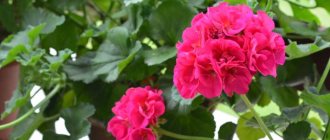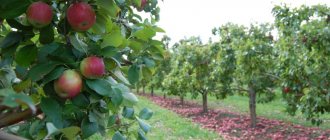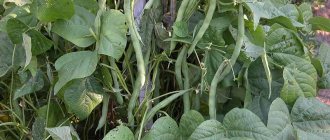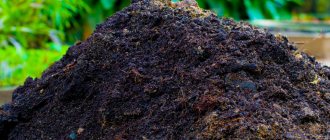Our grandparents did not tie up raspberries - the old varieties had small berries that rarely broke. Modern raspberries require garter, the quality and quantity of the harvest depends on this. This needs to be done correctly; simply tying a bush to a pole with twine is not enough.
We'll tell you about the main methods of gartering raspberries and give information on some of the nuances. Let's talk separately about the garter to a single, double and free trellis.
Is it possible to grow raspberries without a garter?
Not all raspberries need additional support: low bushes that do not form large berries cope well with unfavorable conditions and do not break. However, yellow and remontant raspberries, when grown without a trellis, can respond with a decrease in yield and a deterioration in the taste of the berries.
A garter is needed in the following cases:
- the site or area is subject to strong winds;
- tall variety;
- The berries are large, located compactly along the upper part.
It’s good if all the work is done before the buds swell. An autumn garter is also possible, its purpose is to protect the plant from the mass of snow and prevent the raspberries from breaking.
In the summer they tie it up in exceptional cases: if it has not been done before or incorrectly. At the same time, they work carefully so as not to break the fragile branches.
Materials used for garter
The best materials for gartering raspberry plantations have always been considered:
- nylon tapes or threads;
- wooden slats 2 m long;
- precast concrete pipes;
- metal posts;
- stakes made of wood or plastic;
- steel bars;
- skeins of twine;
- synthetic fabric strips;
- wire with plastic braid;
- twine made of harsh threads.
There are still a lot of different products suitable for knitting. With proper ingenuity, you can come up with many ways to fasten branches to various supports. It is important that the products used do not injure the skin and the branches of the plant themselves.
Methods for gartering raspberries
You can quickly tie up raspberries when the support is prepared in advance. In other cases, you will have to tinker, prepare the appropriate structure - hammer in stakes or install a reliable trellis. In amateur and industrial gardening, 3 main methods of gartering plants are used: bush, fan and trellis. The latter has 3 subspecies that you need to know about.
Bush (to one pole)
The easiest way is to drive a stake into the ground and plant a bush nearby. In the future, leave the shoots growing around the stake and remove the excess ones. Ideally there should be no more than 8 branches.
The height of the stakes is at least 1.8 m. It is better if they are strong posts with a diameter of 5-8 cm, driven 40-50 cm into the ground. The underground part should be treated with compounds that protect against rotting.
Tie raspberries to stakes like this:
- Inspect the bush, remove damaged and weak shoots.
- They retreat 70 cm from the ground and take the bush in a bunch so that the stake is in the middle of the shoots.
- Carefully tie with twine. Loosely so that the stems can grow thicker without hindrance.
- Pull the branches a little to the side so that they bend in an arc.
- The highest branch is attached to a stake near the top of the head.
This way you can tie up raspberries quickly. However, for repair varieties this is not the best option - there will be difficulties with pruning.
It is good to use the bush method to tie up tall plants on small plantations. In a large raspberry farm, the method is labor-intensive and therefore unprofitable.
fan garter
This method also requires many stakes, but allows the branches to be more conveniently positioned, which makes it easier to process with solutions, harvest and other care measures. Raspberries are planted in a row, and strong stakes are hammered or buried between the bushes. Tie it up like this:
- Leave 6-8 of the most powerful stems in the bush.
- Half of the shoots are tilted towards the left stake, half towards the right.
- The branches divided in this way are collected into a bunch and tied at a height of 70-80 cm from the ground.
The fan method ensures the flow of air and sunlight to each leaf and each ovary, which contributes to high yields. One of the disadvantages is the difficulty in determining the length of the shoot: sometimes it does not reach the stake, so it is discarded or left unattached.
Raspberry trellis
The most common way to garter raspberries. The design of the trellis for this crop is simple: they bury pillars at a distance of 1.5-2 m from each other, stretch steel wire between them, nail slats, and screw in reinforcement up to 6 mm thick.
Raspberry shoots are tied to horizontal guides so that each branch receives enough sunlight. The ease of maintenance of the plantation is also taken into account. Therefore, there are several ways to tie raspberries to a trellis, some allow you to do the job quickly and correctly.
Recommendations from experts
To avoid mistakes at the stage of bending raspberries, you should take into account the basic recommendations of experts. Many beginners do not comply with the timing of the procedure and bend the bush before frost. During this period, the stems become brittle and are damaged at the slightest bending, so it is important to have time to tie a raspberry tree earlier, when its shoots remain flexible and curl easily. In mid-latitudes, you can perform this procedure at the end of September or earlier.
Another mistake newbies make is tying the bush in a bun. But this technique is unsafe and impairs the winter hardiness of the crop.
In addition to tying up the shoots, you should remove the leaves. This procedure is mandatory and requires some skills. Since the leaves naturally fall off in autumn and become fragile, they can be removed by hand. The main thing is not to press too hard on the branches, so as not to damage the shoots.
We recommend that you read All about raspberries
After removing the foliage, tie a stone to a bunch of branches and bend it to the ground. In harsh climatic conditions, raspberry bushes need to be additionally covered with heat-insulating materials.
Trellis options for productive raspberries
According to the rules, it is necessary that the distance between the branches be at least 7 cm. Based on this value, the type of trellis is selected - single, double, free-vertical.
A single trellis is a fence in which 3 rows of wire are stretched through posts buried in one line. The lowest one is at a height of 50 cm from the ground, then at a distance of 60 cm. The stems are tied as they grow to each row of wire.
A double trellis is installed according to the same principle, but has 2 rows. The supports for this design are U-shaped. Stretch two rows of wire with a distance of 1 m between them.
A free-vertical trellis allows you to do without tying branches to the structure. It consists of two wires stretched between pillars. The branches are passed between the wires so that they do not move; the wires are fixed together with strips of tin.
When to carry out
Beginning gardeners, faced with growing raspberries for the first time, often wonder when exactly they need to tie up shoots in a raspberry garden and how to do it correctly.
Depending on the purpose, gartering is carried out twice a year: in early spring and late autumn. Spring garter helps prevent the plant from being damaged by pests and diseases, simplifies the care and collection of berries, and ensures abundant fruiting. In the fall, the procedure helps increase the chances of raspberries surviving the winter.
Seasonal features of the procedure
Spring gartering is carried out in early spring, when the night temperature rises above 0°C and the top layer of soil dries out a little.
First of all, a two-stage pruning is carried out: the first time after the snow has just melted, and the second time after the buds open and dry shoots and shoots that have already borne fruit are clearly visible. Next, proceed directly to gartering using any of the selected methods.
Winter garter is necessary to prepare the bush for the cold period. To do this, a wire is pulled between the bushes at a distance of approximately 0.25 m from the ground. The shoots of the plant are bent to this wire and secured using synthetic ropes. In winter, snow cover will protect the branches from severe frosts.
How to tie raspberry branches
There are usually no problems with supporting structures, but gardeners, especially beginners, do not know how easier it is to tie lashes to a support. It’s good if there’s a gardening store nearby that sells plastic clips - they’re the easiest way to attach shoots. Plastic spirals, which are also freely sold, are also suitable.
If you can’t buy a device, you can work with wire - copper, aluminum or galvanized. The main thing is that it bends easily and is not thinner than 2-3 mm, otherwise the shoots will be damaged.
They are tied using the following technology:
- At the desired height, find a place where the stem bifurcates. This can be a branch of a full-fledged shoot or a strong leaf stalk.
- At this point, a wire loop is made around the stem so that there is free space for the stem. The loop cannot crush the tissue and disrupt the flow of sap.
- The free ends of the garter are directed to the trellis wire and then tied around it.
- To prevent the branch from being moved by gusts of wind, it is fixed at 2-3 points using the same method.
- Excess wire is removed with wire cutters or pliers.
If it is impossible to get the wire, tie it with strong twine. However, in this case, you need to regularly inspect the plantation for the reliability of the fastenings: when there are gusts of wind, the twine frays and the stems may break. For reliability, you can double or triple the ropes.
The variety of methods, their pros and cons
There are many ways to garter raspberry bushes, each of which has its own advantages and disadvantages.
- The stake method of tying is characterized by:
- simplicity of the process;
- low cost of materials used.
- However, it also has some disadvantages:
- uneven illumination of shoots by the sun;
- not all ovaries develop evenly;
- increased risk of fungal infection;
- possible injury to shoots during harvesting.
The trellis method is more complex.
It allows:
- young shoots grow freely;
- uniformly illuminate the maximum number of branches;
- ensure air circulation throughout the entire height of the bush;
- harvest without discomfort.
The disadvantages of this method are the complexity and duration of bush formation.
The fan method provides free air circulation and access to the sun to young shoots , but is not very popular among gardeners.
To choose the most convenient way to secure branches, you must first study the features of each of them.
Find out when and how to prune raspberries correctly.
Growing without a garter
If there is no strong wind in your area or the area is surrounded by a continuous high fence, raspberries can be grown without a garter. To do this, it is planted in 2 rows, the distance between them is half a meter. The shoots of the first year are completely preserved and are not cut out in the fall. They become woody and become a strong support for young stems. In the future, the raspberries are not tied up, but kept in a strip 50 cm wide. The shoots growing outside the raspberry tree are removed.
In this way, you can grow any variety with powerful, vertical branches. It is allowed to keep no more than 20 shoots per square meter.
Growing without a garter is not without its disadvantages. The yield here will be lower due to the poorer supply of sunlight to the plant. It will not be possible to control the condition of all branches; plantings located in the depths will die off, so you will have to provide a supply of shoots.
How to properly tie raspberries for the winter and prepare them for frost
We begin preparing raspberries for winter in the summer, or to be more precise, at the end of August. It is at this moment that we feed the bushes with phosphorus and potassium fertilizers, which will best strengthen the root system and prepare it to face the cold and the coming season. And just before the frost we do the last feeding. In addition to these works, we also perform others:
We prune the branches. We begin to do this when the growing season is over, that is, immediately after the final harvest.
Important! It is necessary to prune selectively: firstly, all shoots that bear fruit this year; secondly, all the weak and thin stems of summer growth (but leave the powerful and mature ones)
- We tie up the bushes according to the recommendations that we described above.
- We water the soil under the plants abundantly so that the root system does not become thirsty in winter.
- Mulch the soil with straw, peat or rotted leaves. The layer thickness should be 5-10 cm. Moreover, if the layer is less than the recommended thickness, the plants may die if they cannot withstand the cold. And if there is more, this will also not lead to anything good: fungal and purulent diseases may occur.
Pine needles and pine sawdust are not suitable for raspberries, since they do not like “sour” at all.
How to refine raspberries. Reanimating an old raspberry field
Raspberries are a perennial plant and can grow in one place for about 10 years. But in homestead farms, it is quite rare to see well-groomed and productive 5-6-year-old raspberry plantings. Very often, a raspberry forest looks like an impassable jungle, thickened with root shoots and fruit-bearing shoots that were not cut out in time.
The owners of such a raspberry farm often say: “The raspberry has degenerated...”. Actually this is not true.
Pruning raspberries in the fall - a few “commandments” of a successful gardener
When to prune raspberries - optimal timing
You need to use only sharp pruning shears and monitor the quality of the cut so that the wood does not “chew” or bend the area below the cut. Don’t be afraid to remove more - all the energy will then go into the remaining green mass and will be returned to you in large quantities of fruits next year.
Pruning raspberries can be done immediately after fruiting
Raspberry is a shrub with a round stem, covered with straight thorns and producing many shoots. In the first year, the branches of the plant are green, and then they gradually become woody. In their place, new shoots grow from the same root. The flowers of the plant are small, collected in panicles. Raspberries are usually red. Its pulp has small seeds. Flowering of this representative of the flora begins in June. To get and maintain a good harvest, you need to tie up the plant. We will talk further about how to tie raspberries correctly. This plant is very popular among gardeners and gardeners.
Only fruiting stems are tied to the top; at a distanceA trellis can be made of different types,
Fig. 1 The simplest trellis
50-70 cm
With such a garter
Caring for conventional varieties and the “double cut” method
-
These side shoots of raspberries are also shortened, leaving on each
Do not use stiff wire or tighten it on the shoot
If you think that a properly organized bush is only a decorative decoration for the garden bed, then you are deeply mistaken. This is a necessary operation that will achieve the following goals:
- this is what gardeners do who want to get a large number of stems next year and develop the bush, and not get a large harvest of berries. Most often, after fruiting, unnecessary shoots are immediately cut out and no more than 5-7 shoots are left, which will survive until next year. They can be shortened at a time when the air temperature is below 10 degrees and the movement of juice will slow down significantly.
Types, varieties and ripening times of raspberries 7-10 cm
vertical or inclined
Garter of bushes - its advantages and types
Fig. 2 Sloping trellis
- .
- the picking of berries is made easier and the annual shoots are not damaged (they grow vertically upward in the center of the bush), the access of light and air to the plants is improved and, as a result, the yield is significantly increased.
- Stake garter.
- 3-6 kidneys
- - it grows quickly and will absorb it inside over time, slowing down its growth. It is also worth remembering that closely tied branches are a potential “home” for insects and a future breeding ground for fungal diseases, so try to provide maximum ventilation. Do not install the trellis too high; it is better to pin the top in time and make a fan - you will get much more fruit next year and it will be more convenient to harvest.
Reduce the number of pests and reduce the risk of fungal diseases. A properly organized bush does not darken the ground and is well ventilated, due to which brown and white spots almost never appear on the leaves. The number of insect pests is significantly reduced, for which there is very little shelter.
Techniques that can be used on ordinary varieties will not always work as effectively on remontant varieties of raspberries. Here it is necessary to take into account one feature - they bear fruit almost the entire season, starting from July and ending with the first frosts. Therefore, if you want to get the maximum yield, then shortening the stems in summer and cutting raspberries in the fall will no longer suit you. Some sacrifice the harvest and develop the bush as much as possible in the first 2 years, so that later they can get a lot of berries from two-year shoots. There is no extreme limit when you need to prune raspberries - this can be done even in frosty weather if you want to enjoy the berries longer, but if possible, it is better to hurry.
- Raspberries are divided into the following varieties: traditional, large-fruited and remontant. Each of them has its own advantages and disadvantages.
- one from the other.
- .
Fig. 3 Gartering the stems by weaving twine to the wire on a vertical flat trellisNext yearThe best way to tie raspberries is on the page - Growing raspberries on a trellis
grounde.ru
